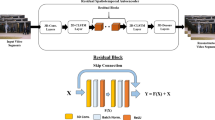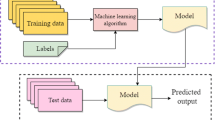Abstract
Real-time video anomaly detection and localization still prevail as a challenging task. Autoencoders are expected to give high reconstruction error for abnormal events than normal events while trained on video segments of normal events. Nevertheless, this assumption is not always true in practice. Sometimes the autoencoder offers better generalization. Therefore, it also reconstructs abnormal events well, leading to slightly degraded performance for anomaly detection. To alleviate this issue, we propose a Skip connected and Memory Guided Network (SMGNet) for video anomaly detection. The memory guided network with skip connection help in avoiding loss of meaningful information such as foreground patterns, in addition to memorizing significant normality patterns. The effect of augmenting memory guided network with skip connection in the residual spatiotemporal autoencoder (R-STAE) architecture is evaluated. The proposed technique achieved improved results over three benchmark datasets.







Similar content being viewed by others
Explore related subjects
Discover the latest articles, news and stories from top researchers in related subjects.References
Biswas S, Babu RV (2013) Real time anomaly detection in h. 264 compressed videos. In: 2013 Fourth national conference on computer vision, pattern recognition, image processing and graphics (NCVPRIPG), IEEE, pp 1–4
Chan TH, Jia K, Gao S, Lu J, Zeng Z, Ma Y (2015) Pcanet: a simple deep learning baseline for image classification? IEEE Trans Image Process 24(12):5017–5032
Chong YS, Tay YH (2017) Abnormal event detection in videos using spatiotemporal autoencoder. In: International symposium on neural networks, Springer, pp 189–196
Dalal N, Triggs B (2005) Histograms of oriented gradients for human detection. In: 2005 IEEE computer society conference on computer vision and pattern recognition (CVPR’05), vol 1, IEEE, pp 886–893
Dalal N, Triggs B, Schmid C (2006) Human detection using oriented histograms of flow and appearance. In: European conference on computer vision, Springer, pp 428–441
D’Avino D, Cozzolino D, Poggi G, Verdoliva L (2017) Autoencoder with recurrent neural networks for video forgery detection. Electron Imaging 2017(7):92–99
Deepak K, Chandrakala S, Mohan CK (2021) Residual spatiotemporal autoencoder for unsupervised video anomaly detection. Sig Image Video Process 15(1):215–222
Del Giorno A, Bagnell JA, Hebert M (2016) A discriminative framework for anomaly detection in large videos. In: European conference on computer vision, Springer, pp 334–349
Dong F, Zhang Y, Nie X (2020) Dual discriminator generative adversarial network for video anomaly detection. IEEE. Access
Feng Y, Yuan Y, Lu X (2017) Learning deep event models for crowd anomaly detection. Neurocomputing 219:548–556
Fritzke B (1995) A growing neural gas network learns topologies. In: Advances in neural information processing systems, pp 625–632
Girshick R (2015) Fast r-cnn. In: Proceedings of the IEEE international conference on computer vision, pp 1440–1448
Gong D, Liu L, Le V, Saha B, Mansour MR, Venkatesh S, Hengel Avd (2019) Memorizing normality to detect anomaly: Memory-augmented deep autoencoder for unsupervised anomaly detection. In: Proceedings of the IEEE international conference on computer vision, pp 1705–1714
Hasan M, Choi J, Neumann J, Roy-Chowdhury AK, Davis LS (2016) Learning temporal regularity in video sequences. In: Proceedings of the IEEE conference on computer vision and pattern recognition, pp 733–742
Hinami R, Mei T, Satoh S (2017) Joint detection and recounting of abnormal events by learning deep generic knowledge. In: Proceedings of the IEEE international conference on computer vision, pp 3619–3627
Ionescu RT, Khan FS, Georgescu MI, Shao L (2019) Object-centric auto-encoders and dummy anomalies for abnormal event detection in video. In: Proceedings of the IEEE conference on computer vision and pattern recognition, pp 7842–7851
Ionescu RT, Smeureanu S, Popescu M, Alexe B (2019) Detecting abnormal events in video using narrowed normality clusters. In: 2019 IEEE winter conference on applications of computer vision (WACV), IEEE, pp 1951–1960
Khan MUK, Park HS, Kyung CM (2018) Rejecting motion outliers for efficient crowd anomaly detection. IEEE Trans Inf Forensics Secur 14(2):541–556
Kratz L, Nishino K (2009) Anomaly detection in extremely crowded scenes using spatio-temporal motion pattern models. In: 2009 IEEE conference on computer vision and pattern recognition, IEEE, pp 1446–1453
Krishna R, Zhu Y, Groth O, Johnson J, Hata K, Kravitz J, Chen S, Kalantidis Y, Li LJ, Shamma DA et al (2017) Visual genome: Connecting language and vision using crowdsourced dense image annotations. Int J Comput Vis 123(1):32–73
Leyva R, Sanchez V, Li CT (2017) Abnormal event detection in videos using binary features. In: 2017 40th international conference on telecommunications and signal processing (TSP), IEEE, pp 621–625
Leyva R, Sanchez V, Li CT (2017) The lv dataset: A realistic surveillance video dataset for abnormal event detection. In: 2017 5th international workshop on biometrics and forensics (IWBF), IEEE, pp 1–6
Li N, Chang F (2019) Video anomaly detection and localization via multivariate gaussian fully convolution adversarial autoencoder. Neurocomputing 369:92–105
Li N, Chang F, Liu C (2020) Spatial-temporal cascade autoencoder for video anomaly detection in crowded scenes. IEEE Trans Multimed 23:203–215
Lin TY, Maire M, Belongie S, Hays J, Perona P, Ramanan D, Dollár P, Zitnick CL (2014) Microsoft coco: Common objects in context. In: European conference on computer vision, Springer, pp 740–755
Liu W, Luo W, Lian D, Gao S (2018) Future frame prediction for anomaly detection–a new baseline. In: Proceedings of the IEEE conference on computer vision and pattern recognition, pp 6536–6545
Lu C, Shi J, Jia J (2013) Abnormal event detection at 150 fps in matlab. In: Proceedings of the IEEE international conference on computer vision, pp 2720–2727
Luo W, Liu W, Gao S (2017) Remembering history with convolutional lstm for anomaly detection. In: 2017 IEEE international conference on multimedia and Expo (ICME), IEEE, pp 439–444
Luo W, Liu W, Gao S (2017) A revisit of sparse coding based anomaly detection in stacked rnn framework. In: Proceedings of the IEEE international conference on computer vision, pp 341–349
Mahadevan V, Li W, Bhalodia V, Vasconcelos N (2010) Anomaly detection in crowded scenes. In: 2010 IEEE computer society conference on computer vision and pattern recognition, IEEE, pp 1975–1981
Medel JR (2016) Anomaly detection using predictive convolutional long short-term memory units. Thesis. Rochester Institute of Technology
Mehran R, Oyama A, Shah M (2009) Abnormal crowd behavior detection using social force model. In: 2009 IEEE conference on computer vision and pattern recognition, IEEE, pp 935–942
Van den Oord A, Schrauwen B (2014) Factoring variations in natural images with deep gaussian mixture models. In: Advances in neural information processing systems, pp 3518–3526
Ramachandra B, Jones M, Vatsavai R (2020) Learning a distance function with a siamese network to localize anomalies in videos. In: The IEEE winter conference on applications of computer vision, pp 2598–2607
Ravanbakhsh M, Nabi M, Sangineto E, Marcenaro L, Regazzoni C, Sebe N (2017) Abnormal event detection in videos using generative adversarial nets. In: 2017 IEEE international conference on image processing (ICIP), IEEE, pp 1577–1581
Shi Y, Tian Y, Wang Y, Huang T (2017) Sequential deep trajectory descriptor for action recognition with three-stream cnn. IEEE Trans Multimed 19(7):1510–1520
Srivastava N, Mansimov E, Salakhudinov R (2015) Unsupervised learning of video representations using lstms. In: International conference on machine learning, pp 843–852
Sun Q, Liu H, Harada T (2017) Online growing neural gas for anomaly detection in changing surveillance scenes. Pattern Recogn 64:187–201
Tran D, Bourdev L, Fergus R, Torresani L, Paluri M (2015) Learning spatiotemporal features with 3d convolutional networks. In: Proceedings of the IEEE international conference on computer vision, pp 4489–4497
Tran HT, Hogg D (2017) Anomaly detection using a convolutional winner-take-all autoencoder. In: Proceedings of the British machine vision conference 2017. British Machine Vision Association
Tudor Ionescu R, Smeureanu S, Alexe B, Popescu M (2017) Unmasking the abnormal events in video. In: Proceedings of the ieee international conference on computer vision, pp 2895–2903
Xingjian S, Chen Z, Wang H, Yeung DY, Wong WK, Woo Wc (2015) Convolutional lstm network: A machine learning approach for precipitation nowcasting. In: Advances in neural information processing systems, pp 802–810
Xu D, Ricci E, Yan Y, Song J, Sebe N (2015) Learning deep representations of appearance and motion for anomalous event detection. arXiv preprint arXiv:1510.01553
Zhao Y, Deng B, Shen C, Liu Y, Lu H, Hua XS (2017) Spatio-temporal autoencoder for video anomaly detection. In: Proceedings of the 25th ACM international conference on Multimedia, pp 1933–1941
Zhao Y, Deng B, Shen C, Liu Y, Lu H, Hua XS (2017) Spatio-temporal autoencoder for video anomaly detection. In: ACM Multimedia
Acknowledgements
This work was supported by No.DST/CSRI/2017/131(G) under Cognitive Science Research Initiative (CSRI), Department of Science and Technology, Government of India.
Author information
Authors and Affiliations
Corresponding author
Ethics declarations
Conflict of interest
The authors have no conflicts of interest to declare.
Additional information
Publisher's Note
Springer Nature remains neutral with regard to jurisdictional claims in published maps and institutional affiliations.
Rights and permissions
About this article
Cite this article
Chandrakala, S., Srinivas, V. & Deepak, K. Residual Spatiotemporal Autoencoder with Skip Connected and Memory Guided Network for Detecting Video Anomalies. Neural Process Lett 53, 4677–4692 (2021). https://doi.org/10.1007/s11063-021-10618-3
Accepted:
Published:
Issue Date:
DOI: https://doi.org/10.1007/s11063-021-10618-3




